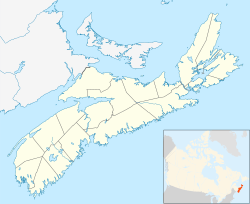Debert Palaeo-Indian Site facts for kids
| Lua error in Module:Wikidata at line 70: attempt to index field 'wikibase' (a nil value). | |
| Location | near Debert, Colchester County, Nova Scotia, Canada |
|---|---|
| Coordinates | 45°25′08″N 63°24′58″W / 45.419°N 63.416°W |
| Type | Settlement |
| Area | 22 acres |
| History | |
| Cultures | Paleo-Indian |
| Site notes | |
| Discovered | 29 August 1948 |
| Excavation dates | 1962–64 |
| Archaeologists | D. S. Byers |
The Debert Palaeo-Indian Site is a very old place where people used to live. It's located near Debert, in Colchester County, Nova Scotia, Canada. This site is super important because it's the oldest and most significant archaeological site found in Nova Scotia. It's also the most north-easterly site found from the Palaeo-Indian time period in North America.
Scientists believe people lived here about 10,500 to 11,000 years ago. What makes it even more special is that it's one of the few ancient settlements found in an area that was once covered by huge glaciers. The Nova Scotia Museum has officially called it a "Special Place" to protect it.
Contents
How the Site Was Found
During World War II, a big air base was built in the Debert area. This base helped move soldiers and supplies from Halifax to Britain. In 1943, they started building more parking lots for military vehicles. This construction, along with some military training, accidentally damaged parts of the ancient site. Only a small piece of the original settlement was left untouched for archaeologists to study. Even so, later tests showed the original living area was at least twenty acres wide.
The site was first discovered on August 29, 1948. A man named E.S. Eaton and his wife were picking blueberries when they noticed some strange objects. Wind had uncovered a few old tools on the ground where the parking lot had been built. Eaton worked at an agricultural college and was also interested in archaeology. He collected these artifacts for several years.
In 1955, Eaton told R.S. MacNeish about the site. MacNeish was the main archaeologist at the National Museum of Canada. He looked at Eaton's finds and marked the site for future investigation. Later, Eaton sold his collection of artifacts to a collector named W.A. Dennis. After Dennis passed away, his collection went to Mount Saint Vincent University. Eventually, the artifacts from Debert were moved to the Nova Scotia Museum of Science in Halifax.
Digging Up the Past
In September 1962, a scientist named D.S. Byers from the Robert S. Peabody Institute of Archaeology in Andover, Massachusetts, did some careful digging. He found parts of the site that had not been disturbed. Because of his findings, Byers planned bigger digs for the summers of 1963 and 1964. These large excavations were led by George Macdonald from the National Museum of Man. The Debert Palaeo-Indian site became a National Historic Site of Canada in 1972.
In 1989, workers at a tree farm in Debert realized their work might be disturbing old remains. Archaeologists from the Nova Scotia Museum and Saint Mary’s University checked the area. They found two new Palaeo-Indian sites, now called Belmont I and Belmont II. More digging happened at these new sites in 1990. They found an undisturbed living area with over 700 artifacts. Many of these tools were very similar to those found at the Debert site. This suggests that all these sites might have been used around the same time.
What We Learned About Palaeo-Indians
Scientists found many stone tools at the Debert site. These tools are special because they are unique to Palaeo-Indian people. Using a method called Radiocarbon dating, scientists figured out that these tools are about 10,600 years old. Over 4,500 artifacts were found across 22 acres of land.
One special tool-making method was called "channel fluting." This is where they would thin the base of a stone tool by removing small flakes. This made it easier to attach the stone tool, like a spear point, to a wooden or bone handle. Large stone knives were also found, which were probably used to butcher animals like caribou. Small, pointed scrapers were also common. These were likely used to clean animal hides.
Archaeologists believe the Debert site was a small hunting camp. It might have been used seasonally by different groups of people over many generations. Since most organic materials (like wood or animal skins) break down over thousands of years, stone tools are the most common things found. However, scientists have found traces of blood on some hunting tools, which they identified as caribou blood. This helps us understand what they hunted.
How Palaeo-Indians Lived
Scientists think the First Peoples came to the Debert area just before a cold period called the Younger Dryas. It's believed that Palaeo-Indians crossed the Bering Strait (a land bridge that once connected Asia and North America). From there, they slowly moved south, then east and north into what is now the Canadian Maritimes.
Archaeologists believe these early settlers were nomadic hunters. This means they moved around a lot to follow herds of caribou, which were their main food source. They also likely hunted smaller animals like fish and birds. To survive the very cold weather, these early people probably wore warm, tailored clothing. For shelter, they likely built tents using wooden frames covered with animal skins.


